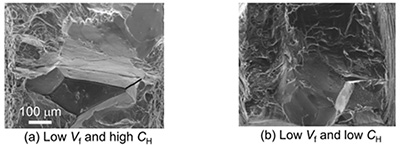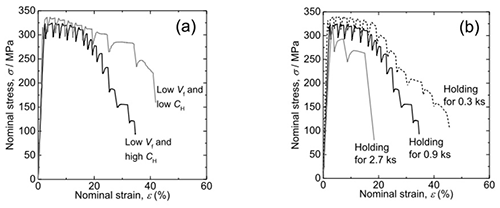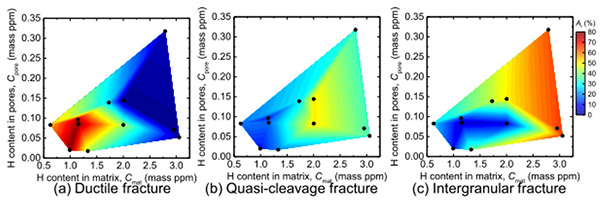1. Introduction
Al-Zn-Mg(-Cu) alloys are high-strength aluminum alloys that are widely used in aircraft and rolling stock, which require high strength-to-weight ratios. When the Zn or Mg content is increased to improve strength, susceptibility to stress corrosion cracking (SCC) increases, leading to delayed fracture. The SCC of Al-Zn-Mg(-Cu) alloys, particularly for crack growth behavior, has been speculated to be strongly related to hydrogen embrittlement (HE). The SCC and HE of aluminum alloys have been investigated by a slow strain rate test (SSRT). In this study, we experimentally clarify the intergranular/quasi-cleavage fracture behavior of Al-Zn-Mg(-Cu) alloys under the influence of hydrogen. Furthermore, the crack morphologies were visualized by imaging-type tomography, developed in recent years, and the crack driving force was analyzed based on the fracture mechanics parameters. In addition, the pores influence the mechanical properties of the aluminum alloys. In this study, both the atomic hydrogen in the matrix and the pores (i.e., molecular hydrogen) were evaluated as factors responsible for the HE.
2. Methodology
A. Specimens
The materials used in this study were Al-10.1Zn-1.2Mg alloy and modified A7150 alloy. The modified A7150 alloy had a chemical composition (in mass %) of 9.9 Zn, 2.3 Mg, 1.4 Cu, 0.06 Si, 0.05 Fe, 0.04 Ti, 0.15 Zr, and balance Al (hereinafter, Al-9.9Zn-2.3Mg-1.4Cu alloy). The shape of the tensile test pieces is the same as that reported in the literature. The gauge length of the tensile test piece was 0.7 mm, and the cross-sectional area was 0.6 × 0.6 mm2. Here, EDM also served as a means of hydrogen charging. In addition, four Al-10.1Zn-1.2Mg alloys were prepared to separate and evaluate the influence of pores and hydrogen in the matrix on fracture behavior. The four Al-10.1Zn-1.2Mg alloys differ in their volume fraction of pores, Vf, and their hydrogen content, CH. As shown in Figs. 1 (b-d), to vary the volume fraction of pores and the hydrogen content, thermal cycle (TC) processes were performed in air and in a vacuum.
B. Synchrotron X-ray imaging and in situ tests
In situ observations of fracture behavior via synchrotron X-ray tomography were performed on BL20XU and BL37XU of SPring-8, Japan. The projection-type tomography configuration was employed to evaluate the fracture behavior of the entire material. To observe the intergranular and quasi-cleavage crack tip with higher resolution, the imaging-type tomography configuration was used.
3. Results
It is found that the fracture strain was increased upon reducing the hydrogen content by the TC process. As shown in Fig. 1, a reduction in the area fraction of intergranular and quasi-cleavage fracture was observed on the fracture surface due to the reduction of the hydrogen content. However, intergranular and quasi-cleavage fracture still occurred in the alloy with reduced hydrogen content. Next, the changes in the HE behavior due to the holding time are discussed based on the results of using the specimen with low Vf and high CH, Fig. 2 shows the nominal stress-nominal strain curves in the tomographic in situ tensile test. The fracture strain was found to decrease with increasing holding time. Cracks may grow during holding, which was observed in particular with a holding time of 2.7 ks. To investigate the relationship between the hydrogen accumulation and intergranular fracture more deeply, a high-hydrogen Al-10.1Zn-1.2 Mg alloy was subjected to EDM twice on the surface. The hydrogen content of this specimen, as measured by TDA, was 25.4 mass ppm. A monotonic tensile load was applied to the specimen until cracking occurred. Then, the loading was stopped, and X-ray projection images continued to be captured under constant displacement. The X-ray projection images of the specimen before and after cracking are shown in Fig. 3. The times shown in Figs. 3 (b-d) are the time elapsed after the displacement was fixed. As is evident in Fig. 3 (a-b), the monotonic tensile load introduced multiple cracks into the specimen. Figs. 3 (c) and (d) show 2D projection images after 65 and 130 s elapsed from Fig. 3 (b) with the displacement fixed. As indicated by the red arrows, continuous intergranular crack progression was observed even when the displacement was fixed. The growth rate was approximately 1 µm/s, and the crack tip was sharp. The influence of the holding time and the hydrogen content on the HE behavior is related to the local accumulation of hydrogen around the crack tips, which is discussed in detail later. The area fractions of ductile, quasi-cleavage, and intergranular fractures are summarized in terms of the hydrogen content in the matrix and the pores, and the results are described in Fig. 4. As the hydrogen content in the matrix increases, the ductile fracture transitions to a quasi-cleavage fracture. When the content increases further, intergranular fracture tends to occur. The appearance of the crack propagating while repeatedly blunting locally and sharpening was visualized. The crack tip and the intergranular crack are sharp, whereas the quasi-cleavage crack exhibits a rugged surface. The rugged surface morphology of the quasi-cleavage crack coincides with the quasi-cleavage facet. With regard to the mechanism of the quasi-cleavage facet formation of steel, the nucleation and growth of nanovoids at the intersection of the slip band ahead of the crack tip have been proposed. However, no void exceeding 300 nm is observed ahead of the quasi-cleavage crack tip for the Al-9.9Zn-2.3Mg-1.4Cu alloy.
4. Conclusion
The HE behavior of Al-10.1Zn-1.2 Mg alloy and Al-9.9Zn-2.3Mg-1.4Cu alloy were analyzed by means of in situ observation using synchrotron projection-type and imaging-type tomography. Similar to the already reported behavior of the Al-9.9Zn-2.3Mg-1.4Cu alloy, HE appeared significant when the holding time of the in situ test increased, and the area fraction of intergranular and quasi-cleavage fracture increased. However, the fracture was not completely brittle, and even the intergranular crack that grew on one grain boundary did not grow in a single step but instead grew progressively by tensile loading. When trace iron was added to the Al-10.1Zn-1.2Mg alloy, the area fraction of intergranular and quasi-cleavage fracture decreased, and HE was suppressed even if the hydrogen content of the material was approximately the same.



